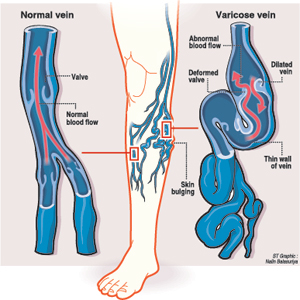Bye-bye to varicose veins with little pain
View(s):You no longer need to get “cut up” to treat this vascular disease, says Consultant Vascular and Transplant Surgeon, Dr. Daminda Rajamantri who discusses the convenience of laser treatment with Kumudini Hettiarachchi
It creeps up suddenly and by the time the symptoms appear, it is often very late. Varicose veins don’t cause symptoms that are noticeable, so they tend to get neglected, says Consultant Vascular and Transplant Surgeon, Dr. Daminda Rajamantri of the National Hospital in Colombo. Even when the symptoms do occur, most people are reluctant to seek treatment for fear of surgery.

Now there is hope in the form of modern techniques including laser treatment, MediScene learns. These are even applicable for neglected varicose veins and people just do not need to get “cut up”.
The “beauty of laser” is that the patient does not undergo general or spinal anaesthesia, only local anaesthesia, according to Dr. Rajamantri. “It’s completely painless except for the tiny jab when the local anaesthesia is administered,” he points out, adding that laser treatment for varicose veins was introduced to the NHSL nearly two years ago, with more than 100 benefiting by it so far.
Varicose veins come in four types, Grades 1, 2, 3 and 4, MediScene understands. Grades 1 and 2 are “nearly harmless” and will usually not develop into the more serious Grades 3 and 4. Essentially, the need is to tackle varicose veins in Grades 3 and 4. (See box on Page 6)
For Grades 3 and 4, under laser treatment, which is a focused light, a thread-like fibre is introduced into the vein through a needle, after the administration of local anaesthesia.
Thereafter, the inner lining of the vein is burnt from within using the laser, Dr. Rajamantri explains, adding that the patient only has to wear a stocking for five days.
In the case of Grade 1 varicose veins — blue or spider veins — the best option is surface laser treatment under which a beam of light is focused on the affected area. The heat causes scar tissue to form, closing the veins and shutting off the blood, making the veins die off.
Referring to other modern advances, he says that in Grade 2 veins, which are a cosmetic problem as they look unseemly, the answer is ambulatory phlebectomy. “Under this minimally-invasive procedure, also known as microphlebectomy or stab avulsion, the affected veins are removed through tiny (1mm) cuts or incisions, once again under local anaesthesia.”
Another treatment is sclerotherapy, where a corrosive chemical, sclerosant, is injected into the vein to damage its inner lining. The patient has to wear a bandage which will make the vein collapse and stick together, causing no more problems with varicose veins.
“Laser treatment can be given even to those who need surgery and also where ulcers have erupted, for a lot of surgeons don’t operate if the patients have an ulcer due to worries about infection,” says Dr. Rajamantri.
The advantages of laser treatment for varicose veins are many — it is a day procedure, there is no hospital stay. “You walk in and walk out,” smiles this Vascular Surgeon. There are also no cuts and no stitches and subsequently no fear of infection.
Contrasting laser treatment with surgery, he says that an operation would require an overnight stay in hospital, while if it is performed in the morning, the patient will be discharged in the evening only if her home is within 20 minutes of travel. Surgery, either ligation (tying off the vein) or stripping (removal of the vein using a cable) would also involve general or spinal anaesthesia as doctors would open up a 1-1.5 inch cut in the groin and also small cuts below the knee.
“In ligation there was also a risk of recurrence of varicose veins and no cosmetic benefit. That was in the past,” says Dr. Rajamantri, cautioning however that some cases may not be suitable for laser because of undue delay.
His simple answer is: Seek medical advice early.
When the one-way valves get affected
When the veins close to the surface of the skin get weak, twisted and enlarged, they are called varicose veins.
Commonly occurring in the legs and ankles, Dr. Rajamantri says that varicose veins are caused when the one-way valves in veins which control the blood flow get affected. When these valves — which ensure that the blood from a person’s legs flows only upwards and towards the heart — get weakened or begin to malfunction, gravity causes the blood to collect in the legs.
There is a build-up of pressure, resulting in varicose veins. Some of the veins can also burst, causing bruising or a change in the colour of the skin.
While heredity may be a reason for some to suffer from varicose veins, the other causes may be standing for a long time and also aging, it is learnt.
Although the prevalence in Sri Lanka of varicose veins is not known, a study carried out 15 years ago on visitors to the National Hospital has given a pointer that it affects about 22%. This is about one in four people, making it quite common, says Dr. Rajamantri.
Usually affecting women, the symptoms of varicose veins are:
- Pain in the leg when standing
- Discomfort, tightness and tiredness of the legs
In the next stage:
- Swelling of the legs towards evening
In the final stage:
- Changes in the colour of the skin in the affected area of the legs. It becomes blue or black
- Itching
- Ulceration (wounds)
Follow @timesonlinelk
comments powered by Disqus
















